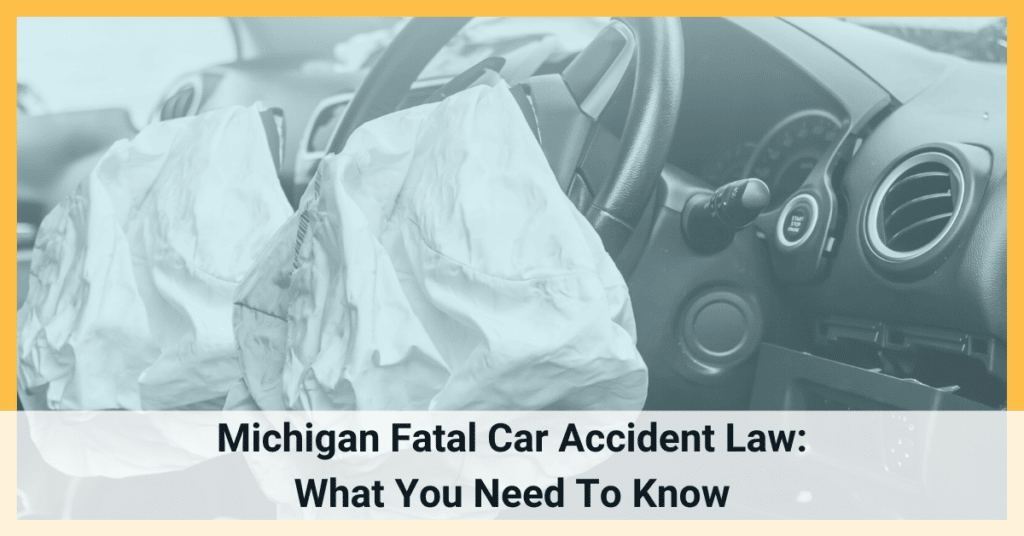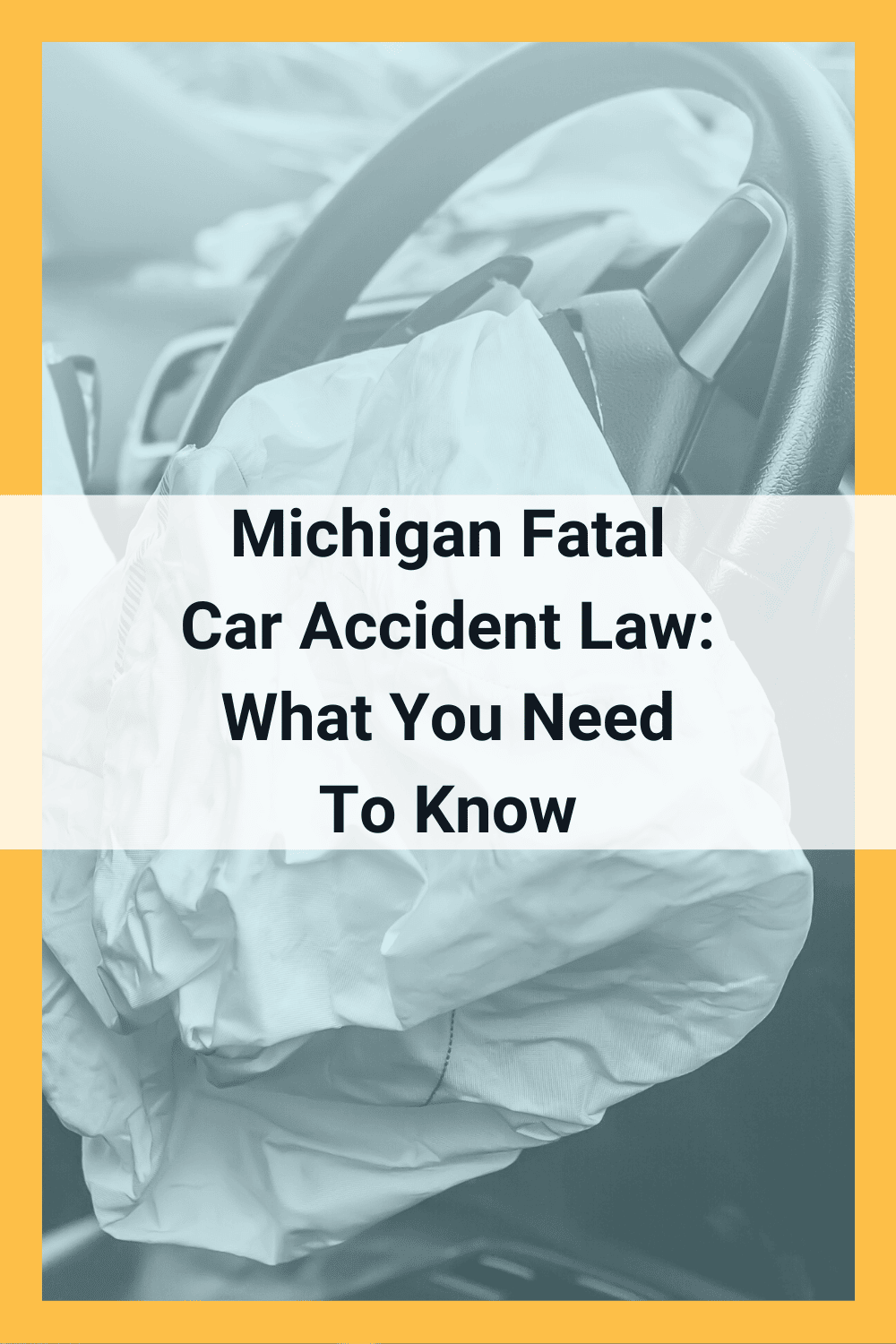Michigan Fatal Car Accident Law: What You Need To Know

Alcohol and excessive speed are leading causes of Michigan fatal car accidents. More than one third of all deadly automobile crashes occur at intersections. Families who have lost a loved one need to speak to an experienced attorney to protect their rights to No-Fault benefits, survivors loss, and wrongful death damages.
What percentage of car accidents are fatal?
Nationally, less than 1% of all the car accidents are fatal and in Michigan in 2021 less than 1% of crashes involved a fatality. There was a total of 282,640 reported motor vehicle crashes in the state in 2021 and 1,068 of them were deadly automobile crashes.
How many Michigan fatal car accidents happen per year?
In 2021, there was 1,068 fatal car accidents in Michigan, resulting in the deaths of 1,131 people. Fatalities from deadly motor vehicle crashes increased from 985 in 2019 to 1,131 in 2021.
What is the leading cause of deadly automobile crashes?
The two leading causes of deadly automobile crashes involve alcohol and excessive speed. Other contributing factors include: (1) the age of the driver (statistically, younger drivers are the most dangerous and most likely to die in an automobile crash, elderly drivers are the second most dangerous); (2) distracted driving, including texting; (3) what the driver was doing immediately prior to the car crash (for example, a left turn is more dangerous than a right turn); and (4) the month, day of the week and the time of day when a person is driving (for example, there is a significant increase in car accidents on Saturdays and Mondays and after clocks are changed with Daylight Savings).
Here are the Michigan fatal car accident statistics for 2021:
- Alcohol – Thirty-one percent (31.5%) of all deadly automobile crashes were “alcohol-involved.” (336 of 1,068) More than 31% of all vehicle crash fatalities resulted from alcohol-involved crashes. (357 of 1,131)
- Excessive speed – Twenty-one percent of all fatalities from deadly automobile crashes resulted from car crashes in which excessive speed was a factor. (237 of 1,131)
- Age – More than 18% (18.3% or 309) of the 1,688 drivers involved in the 1,068 fatal car accidents in Michigan in 2021 were under 25 years of age.
- Distracted driving – Nearly 2% of all fatal car accidents involved a driver who was using a cell phone.
- Month – August was the month with the highest overall number of deadly automobile crashes and the highest overall number of crash-related fatalities.
- Day of the week – Saturday was the day of the week with the highest overall number of deadly automobile crashes.
- Time of day – The period from 6pm to 8:59pm was the time of day with the highest number of deadly motor vehicle crashes, accounting for nearly 19.8% of all deadly crashes.
- Driver actions – The two most common driver actions prior to a deadly automobile crash were “going straight ahead” and “turning left.”
- Hazardous actions – Common hazardous actions by drivers in deadly motor vehicle crashes included driving too fast, failing to yield and careless and negligent driving.
Where do most Michigan fatal car accidents occur?
Thirty-one percent (31.3%) of Michigan fatal car accidents in 2021 occurred at intersections. Nearly 60% (59.5%) of all deadly automobile crashes in the state (636 out of 1,068 total deadly crashes) occurred on county and city roads.
How many fatal car accidents are caused by alcohol in Michigan?
In 2021 in Michigan, there were 336 alcohol-involved fatal car accidents (31.5% of all deadly crashes), resulting in the deaths of 1,131 people (31.6% of all automobile crash fatalities). Also, July was the month with the most “had-been-drinking fatal crashes” and “alcohol-involved fatalities.”
Saturday was the day of the week in Michigan in 2021 with the highest number of “had-been-drinking” deadly crashes.
What happens after a Michigan fatal car accident?
As soon as practical, the first thing that should happen after a deadly automobile crash is the family and dependents of the loved one who was killed should consult with an experienced wrongful death lawyer. Many important No-Fault benefits are available to the family of the deceased, such as survivor’s loss benefits. Unfortunately, many claims adjusters either are not upfront with all the insurance benefits that the family is entitled to under the No-Fault law, or the calculations are wrong, or the survivor’s loss benefits do not include everything a family is allowed, such as funeral and burial expenses, replacement services, social security benefits, disability benefits, and pension compensation.
Grieving family members must be very careful when directly contacted by an insurance company after a deadly vehicle crash. In states like Michigan that do not have bad faith laws, these family members can be easily taken advantage of by misrepresentations made by an insurance company for an at-fault negligent driver. One common example is when a representative or claims adjuster either deliberately or negligently fails to disclose additional policy limits or assets of the negligent driver that would have been applicable to a settlement. Also a claims adjuster or representative for an at-fault driver has no duty to warn family members of the deceased that by accepting a settlement offer they will be violating contractual policy language and voiding the family’s right to collect underinsured motorist coverage. Finally, data from the insurance industry itself shows that families that are contacted directly by an insurance company to settle a claim on average settle the claim for 3 to 4 times less than what an experienced attorney with a proven track record of success can settle for.
Types of insurance claims after deadly crash
After a losing a loved one in a Michigan fatal car accident, you – as a family member and/or dependent – can pursue the following types of insurance claims after a deadly crash: (1) No-Fault survivor’s loss benefits; (2) wrongful death against the at-fault driver; (3) uninsured or underinsured motorist coverage.
No-Fault benefits after a deadly collision
The dependents of a person who was killed in an automobile crash can seek No-Fault benefits after a deadly collision. They are called “survivors loss benefits” and they provide dependents with the financial support their loved one would have provided had he or she not lost his or her life in the car crash.
Suing for wrongful death
The family of a person who was killed in an automobile crash can sue the at-fault driver under the Wrongful Death Act. A wrongful death lawsuit must be brought by the personal representative of the deceased person’s estate. Damages can be sought for pain and suffering, loss of financial support and loss of society and companionship.
Filing a lawsuit
The dependents of a loved one who is killed in a automobile crash must file an application for No-Fault benefits – also known as a written notice of injury – within one year of the crash that resulted in death. The wrongful death statute of limitations is the general 3-year period for all personal injury claims.
About deadly automobile crash settlements
There are many factors that influence how much money a deadly motor vehicle crash settlement will be. Your choice of an attorney is one of the most important. Insurance companies use claims software to evaluate exposure and risk for car accidents, and having an experienced lawyer with an established history of successful settlements and trial verdicts can increase a car accident settlement by 3 to 4 times more.
Need help finding the right lawyer after a crash? Call Michigan Auto Law
If you have tragically lost a loved one in a Michigan fatal car accident and would like to speak with an experienced wrongful death attorney who is experienced with the Wrongful Death Act, No-Fault insurance benefits, Survivor’s Loss benefits, and other important areas of the law that will apply after a deadly crash has occurred, call toll free anytime 24/7 at (800) 968-1001 for a free consultation with one of our injury lawyers. You can also get help from an experienced accident attorney by visiting our contact page or you can use the chat feature on our website.
(Source: Michigan Traffic Crash Facts, “2019 Quick Facts”; Michigan Traffic Facts, “Statewide 2018-2019 Summary Trends: 1 Year Trends,” “Persons [Killed] In Alcohol-Involved Crashes”; Michigan Traffic Crash Facts, Statewide 2019, “Alcohol/Drugs,” “Alcohol Involvement in Fatal Crashes,” “Crash,” “Highway Class,” “Time and Severity,” “Vehicle/Driver,” “Action Prior to Crash” and “Driver Hazardous Action”; Michigan Traffic Crash Facts, Fact Sheets, 2019, “Speeding” and “Cell Phone Use”)






